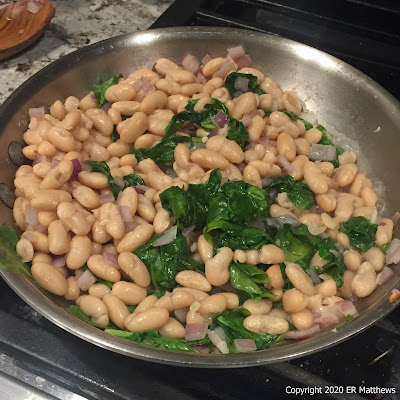There must be foods in everyone's lives, if they ever take the time to reflect on it, that are somehow meaningful in ways that have nothing to do with alleviating hunger, foods that conjure memories. Perhaps it is a dish that grandma used to make, a dessert eaten on a first date, or a secret midnight snack to satisfy a particular craving. In my life, many such dishes make me feel things. Topping the list, perhaps, is white beans with squid and arugula, a dish that I made once again just recently.
 |
| Squid, White Beans and Arugula |
On the face of it, it is a trivially constructed dish consisting of cannellini beans, baby arugula, raw red onions, and lightly cooked squid dressed with lemon juice, olive oil, salt, and oregano. It is so simple that to taste it is to know how to make it. But it is one of those amazing dishes whose flavors and textures are transcendent, that are more than the sum of the parts. One of my former sous chefs calls it "a perfect dish," high praise indeed.
I cannot in any way take credit for this dish. My history with this dish started in Richmond, VA in the 1980s. Once upon a time, I used to spend pretty much every weekend in Richmond, commuting from my apartment in the DMV in suburban Maryland.
On Richmond's Oregon Hill across from the Virginia War Memorial on the north bank of the James River in a building that looks boarded up sits a restaurant called Mamma 'Zu, a self-styled Italian restaurant that really puts the D in dive. It has no décor to speak of, no fancy furnishings, a surly host, a no-nonsense menu written on a chalkboard, and a wine rack in the back. If you want a bottle of wine, you go to the back and grab a bottle and bring it to your table, or that was the drill 35 years ago.
It is a polarizing restaurant: people love it or they hate it. The restaurant has a well-deserved reputation for taking shit from nobody. They don't accept credit cards, they don't modify their dishes, and you follow their rules or you hit the road. It is a place where the host is intimidating and if you act intimidated, you could be in for a long night. It is also a place where the vibe is chaotically electric and the cooks are jammed into a tiny hell hole of an inferno.
But they turn out some exquisite food. They don't list their excellent pizza anywhere, but if you go there enough, you'll see pizzas coming out along with mounds of pasta. But what I went there for was impeccable seafood. The menu would mainly list the name of the fish and a price, such as "Sardines 24" and "Rockfish 30" and you just ordered them. Woe be unto the newbie who enquired about a preparation or worse, asked for a change in a dish. Me, I never cared. My trust in the kitchen was implicit.
My favorite was an appetizer called Squid, White Beans, and Arugula, the very same dish that you see above, a dish which my then-wife would not touch. I loved it so much that it had to be on the table every time we ate there, which was regularly. Sometimes we would venture to their second location near VCU in The Fan District, a restaurant called Edo's Squid which also had this same dish on the menu. I never liked the swankier location as much, but the food was just as good.
We continued to visit Mamma 'Zu with nearly every trip to Richmond for many years. Fast forward fifteen years or so to a point at which I had opened my own restaurant. One day, into the restaurant walks a young cook looking for employment at a point when I had just lost my sous chef. On the strength of his resume which included stints at both Mamma 'Zu and Edo's Squid, I hired him (and he has gone on to helm many of his own kitchens). In the bustle of getting a new restaurant off the ground, I had put squid and white beans to the back of my mind. He inspired me to put the squid dish on our menu occasionally.
My restaurant was located in Winchester, VA at the very northern point of the state, far, far closer to Pennsylvania than Richmond. The primary industry in Winchester is the hospital which is a large regional trauma center serving a vast geographic area. Many of the employees of the hospital and associated doctor's practices trained at MCV in Richmond and were familiar with the dish from Mamma 'Zu and/or Edo's Squid, which is located just a few blocks west of the hospital.
Many was the transplanted Richmonder who would call me and ask me to make the dish for them on their visit to my restaurant. Such is the nature of the dish that it inspires great loyalty. I have great memories of all the friends and customers who loved this dish as much as I do.
To keep in touch with this dish, I make it from time to time at home. Ann and I both love it. For me, it brings back memories of when I was young, a favorite restaurant, a young sous chef who has gone forth to do great things, of my restaurant and special customers, and of a meal that really resonates with Ann and me. She doesn't have the connection to the dish that I do, but she is the reason that I continue to make it.

























































